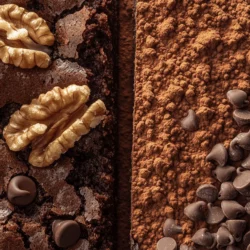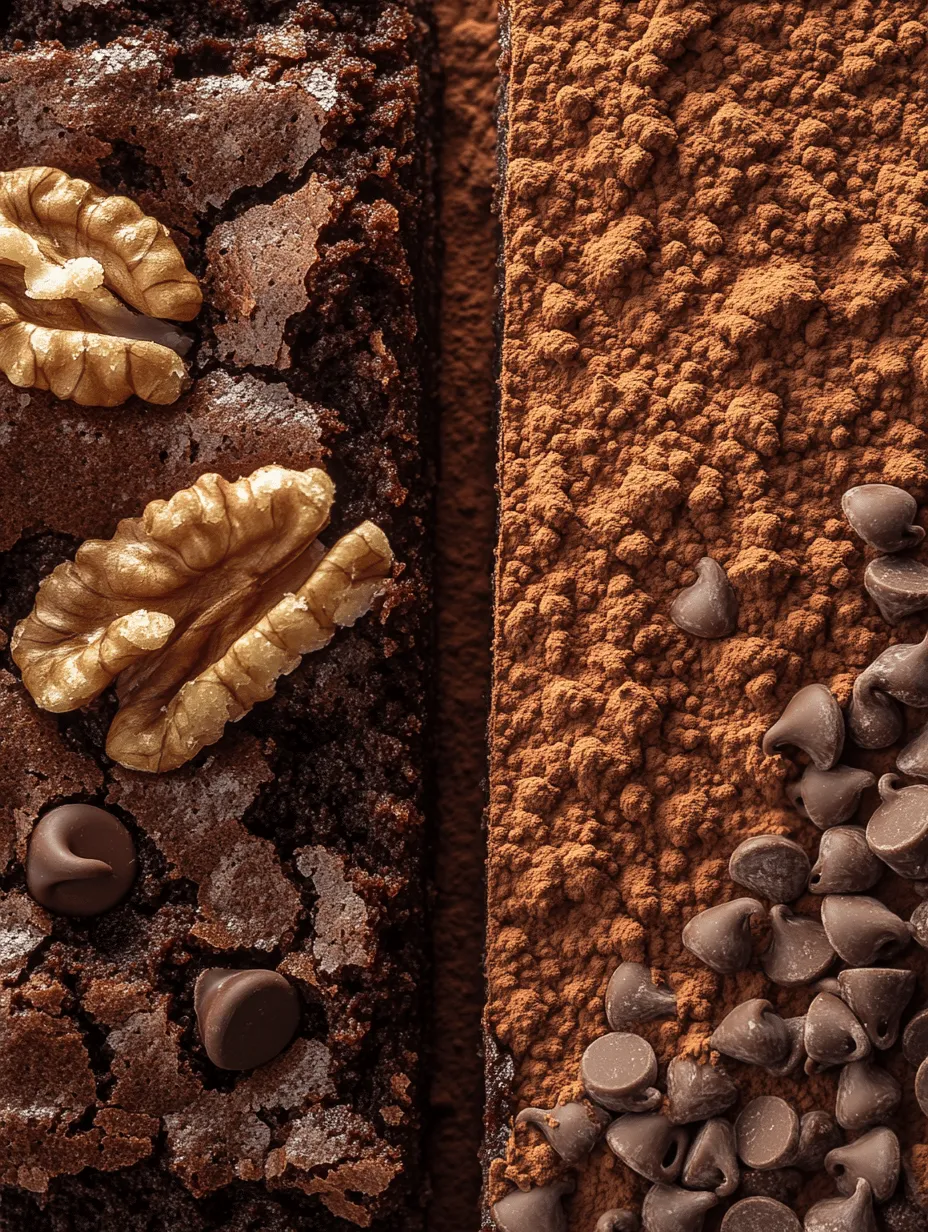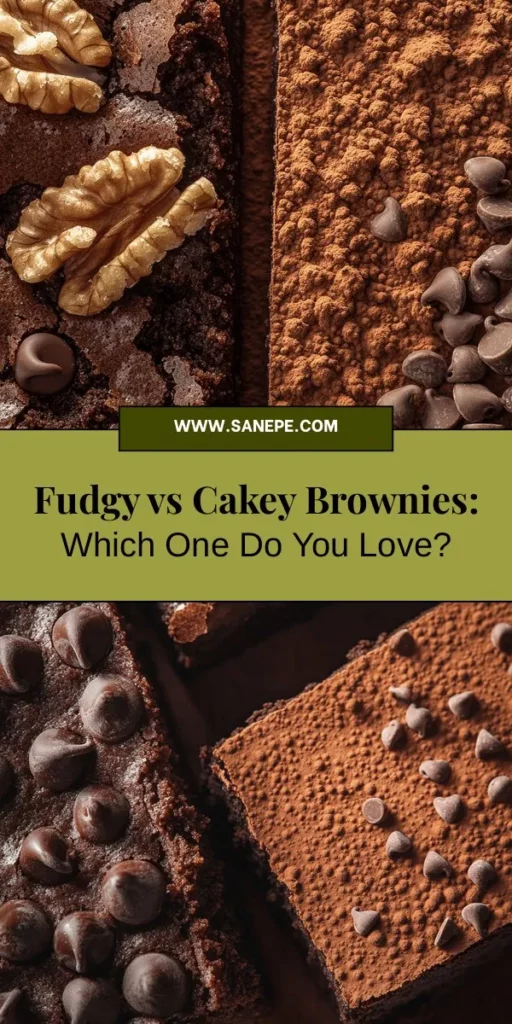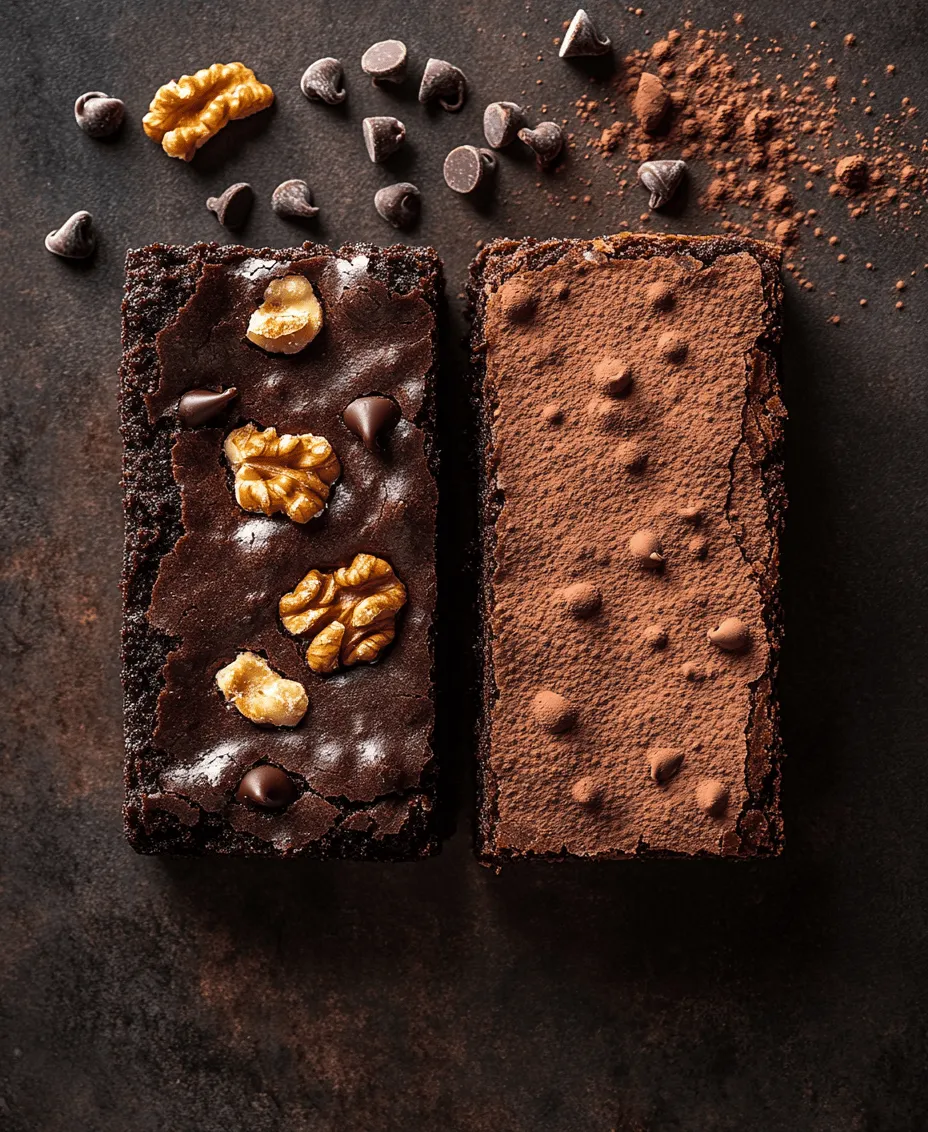Introduction
There’s an undeniable love for brownies that transcends age, culture, and culinary expertise. These delectable treats have carved out a cherished space in dessert culture, often evoking fond memories of family gatherings, bake sales, and late-night cravings. Whether enjoyed on their own, paired with a scoop of ice cream, or drizzled with caramel sauce, brownies have become a staple dessert that continues to delight palates everywhere.
Within the world of brownies, however, a spirited debate rages on: fudgy or cakey? This discussion is not merely about personal preference; it dives deep into the realms of texture, flavor, and the very essence of what makes a brownie a brownie. While some bakers advocate for the rich, gooey indulgence of fudgy brownies, others champion the lightness and fluffiness of cakey brownies. This article aims to explore these two distinct styles, breaking down their differences, examining their ingredients, and providing detailed preparation methods. By the end, readers will be equipped to choose their favorite brownie style or perhaps even discover a new appreciation for both.
Understanding Brownies
At its core, a brownie is a baked chocolate dessert that has gained immense popularity due to its rich flavor and delightful texture. Originating in the United States in the late 19th century, brownies have evolved from a simple chocolate cake into a variety of styles and flavors, making them a versatile treat that can be customized to suit any occasion. The foundational elements of brownies are often similar, yet the final product can vary significantly based on the method of preparation and the proportions of ingredients used.
The two primary styles of brownies, fudgy and cakey, differ mainly in texture and moisture content. Fudgy brownies are dense, rich, and chewy, providing a decadent experience with each bite. They often have a higher fat content, resulting in a moist, gooey center that chocolate lovers crave. On the other hand, cakey brownies tend to be lighter and airier, resembling a cake more than a traditional brownie. They feature a higher proportion of flour and leavening agents, resulting in a crumbly texture that pairs well with a variety of toppings and accompaniments.
Understanding the importance of texture and flavor is crucial when diving into the world of brownies. Fudgy brownies often boast a deep chocolate flavor with a satisfying chew, while cakey brownies deliver a lighter chocolate experience that can be enhanced with frostings, whipped cream, or fresh fruit. This article will delve into each style, starting with the beloved fudgy brownie.
Fudgy Brownies
Fudgy brownies are often considered the ultimate chocolate experience. Their dense, moist texture is a result of a careful balance of ingredients that prioritize fat and sugar over flour. These brownies are characterized by their rich chocolate flavor, which can be accentuated by the addition of chocolate chips or chunks. When baked to perfection, fudgy brownies have a shiny, crackly top layer that gives way to a soft, gooey interior.
Ideal occasions for serving fudgy brownies abound. From birthday parties to holiday gatherings, these brownies can be the star of any dessert table. Their indulgent nature makes them perfect for serving alongside vanilla ice cream or topped with a dollop of whipped cream. Whether enjoyed warm or at room temperature, fudgy brownies are sure to please any chocolate lover.
Ingredients for Fudgy Brownies
To create the perfect fudgy brownie, it’s essential to understand the role of each ingredient used in the recipe. Here’s a detailed breakdown of the key components:
– Unsalted Butter: Butter is the primary source of fat in fudgy brownies, contributing to their moist texture. Unsalted butter allows for better control over the overall saltiness of the brownies.
– Semi-Sweet Chocolate Chips: Using high-quality semi-sweet chocolate enhances the brownie’s rich chocolate flavor. The melted chocolate combined with cocoa powder provides the fudginess that many crave.
– Granulated and Brown Sugar: A combination of granulated and brown sugar not only sweetens the brownies but also adds depth to their flavor. Brown sugar, with its molasses content, contributes to the chewy texture and enhances the overall taste.
– Eggs: Eggs serve as a binding agent in the recipe. They provide moisture and richness while also helping to create a fudgy texture when combined with the other ingredients.
– Vanilla Extract: This ingredient adds a subtle aroma and flavor, enhancing the overall taste of the brownies.
– All-Purpose Flour: Flour provides structure to the brownies. Fudgy brownies typically use less flour than cakey variants to maintain that desired density.
– Salt: A pinch of salt elevates the flavors and balances the sweetness of the sugars, resulting in a more complex taste.
– Optional Nuts (Walnuts or Pecans): Adding nuts provides a delightful crunch and enhances the texture of the brownies. While some prefer the classic fudgy experience, others enjoy the added dimension that nuts bring.
Instructions for Fudgy Brownies
Now that we’ve established the importance of each ingredient, let’s dive into the step-by-step guide to preparing fudgy brownies. Follow these detailed instructions to create a batch of rich, gooey brownies that will impress your family and friends:
1. Preheat the Oven and Prepare the Baking Dish: Start by preheating your oven to 350°F (175°C). Prepare an 8×8-inch baking dish by greasing it with butter or lining it with parchment paper, allowing for easy removal of the brownies once they’ve cooled.
2. Melt Chocolate and Butter Together: In a medium-sized heatproof bowl, combine the unsalted butter and semi-sweet chocolate chips. Set the bowl over a pot of simmering water (double boiler method) or melt in the microwave in short bursts, stirring frequently until completely smooth and combined.
3. Mix Sugars and Incorporate Eggs: In a separate bowl, whisk together the granulated sugar, brown sugar, and eggs until well combined. Add the melted chocolate and butter mixture to the sugar and egg mixture, stirring until smooth. Then, incorporate the vanilla extract.
4. Folding in Flour and Nuts: Gradually add the all-purpose flour and salt to the chocolate mixture, stirring gently until just combined. Be careful not to overmix, as this can lead to denser brownies. If desired, fold in any optional nuts at this stage.
5. Bake and Test for Doneness: Pour the brownie batter into the prepared baking dish, spreading it evenly. Bake in the preheated oven for 20-25 minutes, or until a toothpick inserted into the center comes out with a few moist crumbs. Allow the brownies to cool in the pan before cutting them into squares.
Cakey Brownies
While fudgy brownies often steal the show, cakey brownies have their own unique appeal. Cakey brownies are characterized by their lighter texture, resembling a slice of chocolate cake. They are often less dense than their fudgy counterparts, making them a delightful option for those who prefer a more airy dessert. Cakey brownies feature a slightly higher amount of flour and often include baking powder or baking soda to help them rise during baking.
These brownies are perfect for serving alongside a cup of coffee or tea, offering a lighter dessert option that can be enjoyed at any time of day. Their versatility allows for various flavor additions and variations, such as swirls of cream cheese or layers of fruit, making them a favorite among those who enjoy experimenting in the kitchen.
As we continue in this article, we will explore the specific ingredients and preparation methods needed to create the perfect cakey brownie, allowing readers to appreciate the diverse world of brownies fully. Whether you’re team fudgy or team cakey, mastering both styles will elevate your baking repertoire and satisfy any chocolate craving.
Ingredients for Cakey Brownies
Creating the perfect cakey brownie involves a specific selection of ingredients that each play a crucial role in achieving the desired texture and flavor. Here’s an in-depth analysis of each ingredient’s function in the cakey brownie recipe:
Unsalted Butter
Unsalted butter is the foundation of many baking recipes, including cakey brownies. It not only adds richness and flavor but also contributes to the overall moisture of the brownie. By using unsalted butter, you have better control over the salt level in your brownies, allowing you to enhance the sweetness and chocolate flavor.
Granulated Sugar
Granulated sugar serves two primary purposes in cakey brownies: it sweetens and contributes to the structure. The sugar dissolves during the mixing process, aiding in the incorporation of air into the batter, which helps create a light and fluffy texture. The amount of sugar used also affects the overall sweetness and moistness of the brownies.
Eggs
Eggs are essential for binding the ingredients together and providing structure. They also add moisture and richness, which are critical for creating a cakey texture. The number of eggs can influence the density of the final product: more eggs lead to a lighter and fluffier brownie, while fewer eggs create a denser texture.
Vanilla Extract
Vanilla extract acts as a flavor enhancer, elevating the overall taste of your brownies. It adds warmth and depth to the chocolate flavor, complementing the richness of the butter and sugar. Opting for pure vanilla extract instead of imitation can significantly improve the flavor profile.
All-Purpose Flour
All-purpose flour is the backbone of any cake or brownie recipe. It provides structure and stability, allowing the brownies to rise appropriately. The gluten formed during mixing gives the brownies a cakey texture. Be careful not to overmix, as this can lead to tougher brownies.
Unsweetened Cocoa Powder
Cocoa powder is responsible for the rich chocolate flavor in brownies. For cakey brownies, using unsweetened cocoa powder ensures that you can balance sweetness and chocolate intensity. The type of cocoa powder (natural versus Dutch-processed) can also affect the flavor and color of the final product.
Baking Powder
Unlike fudgy brownies that rely on the density of the batter, cakey brownies require a leavening agent to achieve a light and airy structure. Baking powder introduces air bubbles into the batter during baking, allowing the brownies to rise and develop a cake-like texture.
Salt
Salt is a critical ingredient in baking that enhances flavors and balances sweetness. A small amount of salt in the brownie batter can elevate the chocolate flavor and improve the overall taste experience.
Optional Chocolate Chips
While optional, adding chocolate chips can enhance the chocolate flavor and provide a delightful texture contrast. They can melt into the batter, creating pockets of gooey chocolate, or add extra sweetness and richness.
Instructions for Cakey Brownies
Follow these detailed steps to create your perfect batch of cakey brownies.
Preparing the Oven and Baking Pan
1. Preheat the Oven: Begin by preheating your oven to 350°F (175°C). This ensures that your brownies cook evenly.
2. Prepare the Baking Pan: Grease a 9×13-inch baking pan with butter or line it with parchment paper for easy removal after baking. If using parchment paper, leave some overhang for easy lifting.
Melting the Butter and Mixing Sugars
3. Melt the Butter: In a medium saucepan, melt 1 cup (2 sticks) of unsalted butter over low heat. Remove from heat once melted and allow it to cool slightly.
4. Combine Butter and Sugar: In a large mixing bowl, combine the melted butter with 2 cups of granulated sugar. Whisk together until well blended. The mixture should be smooth and glossy.
Incorporating Eggs and Vanilla
5. Add Eggs: Crack in 4 large eggs, one at a time, whisking vigorously after each addition. This helps incorporate air into your batter for a lighter texture.
6. Stir in Vanilla: Add 2 teaspoons of vanilla extract and mix until fully incorporated.
Whisking Together Dry Ingredients
7. Combine Dry Ingredients: In a separate bowl, whisk together 1 cup of all-purpose flour, 1 cup of unsweetened cocoa powder, 1 teaspoon of baking powder, and ½ teaspoon of salt. This ensures that the leavening agent is evenly distributed throughout the batter.
Combining Wet and Dry Components
8. Mix Wet and Dry Ingredients: Gradually add the dry mixture to the wet mixture, folding it in with a spatula until just combined. Be careful not to overmix, as this can lead to dense brownies. If desired, fold in 1 cup of optional chocolate chips at this stage.
Baking and Checking for Doneness
9. Pour the Batter into the Pan: Spread the brownie batter evenly into the prepared baking pan.
10. Bake: Place the pan in the preheated oven and bake for 25-30 minutes. Start checking for doneness at the 25-minute mark. The brownies are ready when a toothpick inserted into the center comes out with a few moist crumbs but not wet batter.
Comparative Analysis: Fudgy vs. Cakey Brownies
Textural Differences
Fudgy brownies are dense and moist, offering a rich, gooey experience that melts in your mouth. On the other hand, cakey brownies have a lighter texture that resembles cake, with a fluffy crumb and a slightly drier finish. The difference in the ratio of flour to fat and the addition of leavening agents creates these distinct textures.
Flavor Profiles
When it comes to flavor, fudgy brownies often have a more intense chocolate taste due to the higher fat content and less flour, which allows the chocolate to shine. Cakey brownies, while still chocolatey, have a more balanced sweetness thanks to the flour and sugar combination, resulting in a lighter flavor profile that can sometimes be enhanced with additional flavors like vanilla or nuts.
Visual Differences
Visually, fudgy brownies are often darker and denser, with a shiny top, while cakey brownies can appear more cake-like, with a lighter, crumbly surface. Both types can be served in squares, but the presentation may differ slightly; cakey brownies might be garnished with powdered sugar or frosting, while fudgy brownies are often served plain or with a scoop of ice cream.
Popular Preferences
Popularity can vary by personal taste and cultural context. In many cases, fudgy brownies are favored for their indulgent richness, making them a go-to choice for chocolate lovers. However, some prefer the lighter texture of cakey brownies, especially those who enjoy a dessert that has a more cake-like consistency. This preference also often aligns with dietary considerations, as some bakers may opt for cakey versions when looking for a lighter dessert option.
Cultural Context of Brownies
Brownies in Popular Culture
Brownies have become a staple in American baking culture since their inception in the late 19th century. Initially, they were introduced as a type of chocolate cake baked in a pan, but over time, variations have emerged, leading to the fudgy and cakey distinctions we know today. Brownies have been featured in countless cookbooks, food blogs, and even movies, solidifying their place as a beloved dessert.
Variations and Adaptations
Around the world, brownies have taken on various forms and adaptations. For instance, in Brazil, “brownies” might include unique ingredients like guaraná or coconut. Other countries have embraced gluten-free or vegan versions, catering to those with dietary restrictions while maintaining the essence of the classic brownie.
Rise of Specialty Brownies
The rise of specialty brownies reflects a growing trend toward inclusive baking. Many bakers are now exploring gluten-free and vegan brownie options, using alternative flours like almond or coconut flour and incorporating ingredients like flaxseeds for binding. This innovation has allowed more people to enjoy brownies while still catering to health-conscious trends and dietary limitations.
Conclusion
In the ultimate showdown between fudgy and cakey brownies, both types bring unique attributes to the table. Fudgy brownies charm with their rich, gooey texture and deep chocolate flavor, while cakey brownies offer a lighter, more cake-like experience that can be just as delightful. You may find that your preference leans towards one type over the other, but there’s no denying the joy that both versions bring to gatherings, celebrations, and even quiet afternoons at home.
As you embark on your brownie-baking journey, consider trying both recipes to discover which satisfies your sweet tooth. Regardless of which brownie you prefer, the act of baking and sharing these treats with friends and family is what truly enhances the experience. Brownies, in all their forms, continue to be a timeless dessert, cherished by many and sure to evoke smiles and warm memories. So gather your ingredients, preheat that oven, and enjoy the delightful adventure of brownie baking!



